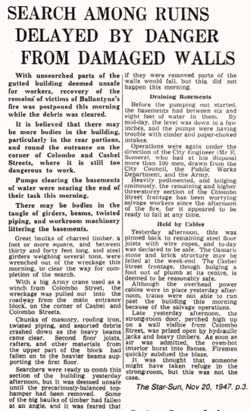Search among ruins delayed by danger from damaged walls.
The Star-Sun, Nov 20, 1947. p.3.
With unsearched parts of the gutted building deemed unsafe for workers, recovery of the remains of victims of Ballantyne’s fire was postponed this morning while the debris was cleared.
It is believed that there may be more bodies in the building, particularly in the rear portions, and round the entrance on the corner of Colombo and Cashel Streets, where it is still too dangerous to work.
Pumps clearing the basements of water were nearing the end of their task this morning.
There may be bodies in the tangle of girders, beams, twisted piping, and workroom machinery littering the basements.
Great baulks of charred timber a foot or more square, and between thirty and forty feet long, and steel girders weighing several tons, were wrenched out of the wreckage this morning, to clear the way for completion of the search.
With a big Army crane used as a winch from Colombo Street, the wreckage was pulled out into the roadway from the main entrance block, on the corner of Cashel and Colombo Streets.
Chunks of masonry, roofing iron, twisted piping, and assorted debris crashed down as the heavy beams came clear. Second floor joists, rafters, and other materials from the upper part of the block had fallen on to the heavier beams supporting the first floor.
Searchers were ready to comb this section of the building yesterday afternoon, but it was deemed unsafe until the precariously balanced top-hamper had been removed. Some of the big baulks of timber had fallen at an angle and it was feared that if they were removed parts of the walls would fall, but this did not happen this morning.
Draining basements
Before the pumping out started, the basements had between six and eight feet of water in them. By mid-day, the level was down to a few inches, and the pumps were having trouble with cinder and paper-choked intakes.
Operations were again under the direction of the City Engineer (Mr E Somers), who had at his disposal more than 100 men, drawn from the City Council, the Public Works Department, and the Army.
Heavily pedimented, and bulging ominously, the remaining and higher three-storey section of the Colombo Street frontage has been worrying salvage workers since the afternoon of the fire, for it appeared to be ready to fall at any time.
Held by Cables
Yesterday afternoon, this was pinned back to remaining steel floor joists with wire ropes, and today was declared to be safe. The Oamaru stone and brick structure may be felled at the weekend. The Cashel Street frontage, though bulging a foot out of plumb at its centre, is deemed to be reasonably safe.
Although the overhead power cables were in place yesterday afternoon, trams were not able to run past the building this morning because of the salvage operations.
Late yesterday afternoon, the strong room door, perched high up on a wall visible from Colombo Street, was prized open by hydraulic jacks and heavy timbers. As soon as air was admitted, the oven hot interior burst into flames. Firemen quickly subdued the blaze.
It was thought that someone might have taken refuge in the strong-room, but this was not the case.


 Discover your family’s history at our libraries
Discover your family’s history at our libraries

